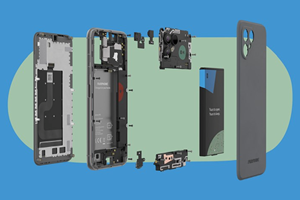Premium Aerotec presents thermoplastic CFRP A320 pressure bulkhead
Premium Aerotec shows the potential that CFRP with a thermoplastic matrix holds for the future with the world’s first demonstrator for an A320 pressure bulkhead.
The aerostructures supplier Premium Aerotec (Augsburg, Germany) has developed and manufactured a major component in the Airbus A320’s primary structure in carbon fiber-reinforced plastic (CFRP) with a thermoplastic matrix. The full-scale and close-to-production demonstrator for the pressure bulkhead of the A320 Family was developed and produced by the company in around four months and was presented at the ILA airshow in Berlin, Germany in April.
With this innovation Premium Aerotec expands the application spectrum for CFRP with a thermoplastic matrix in the aircraft fuselage, far beyond its current usage in small parts. In cooperation with partners, the company is now proving its ability to develop and manufacture large aircraft components made out of CFRP with a thermoplastic matrix.
The pressure bulkhead demonstrator consists of eight segments of equal size connected to each other using state-of-the-art welding technology. The weldability of thermoplastics constitutes an advantage of this material. Premium Aerotec uses this property as a substitute for traditional riveting, which saves on time and costs. The entire development and design was executed by Premium Aerotec, and manufacturing of the individual components was done in cooperation with the Institute for Composite Materials (IVW, Kaiserslautern, Germany). Premium Aerotec developed a technical solution for welding warped components in cooperation with the DLR Centre for Lightweight Construction Production Engineering (Augsburg, Germany).
In comparison to the current traditional pressure bulkhead for the A320 Family, created with riveted aluminium components, the CFRP version weighs less but has the same mechanical properties, as well as having shorter production times and more economic manufacturing costs. Over the next few months, Premium Aerotec will gather more knowledge on the technologically expedient design and efficient construction for creating large components like these from thermoplastic CFRP and drive the qualification of the necessary processes forward.
Premium Aerotec’s expertise with thermoplastic materials is gleaned from using them in smaller parts in the A350 XWB for many years. Here, thermoplastic material is used to connect CFRP frames with CFRP skin sections, to give an example. Premium Aerotec manufactures over 4,000 CFRP components with a thermoplastic matrix like these per aircraft using a highly automated volume production process. This technology can now also be used for larger aircraft components and combined with welding procedures. The presented demonstrator shows that this concept lays a significant part of the foundations for the next generation of aircraft fuselage shells with high production rates.
In addition to the development of the pressure bulkhead demonstrator, Premium Aerotec is also pushing the advance in thermoplastic technology forward in publicly funded projects. At the start of 2018, the OSFIT project (One-Step Fully Integrated Thermoplastic Frames) for developing thermoplastic frames began, sponsored by the Federal Ministry for Economic Affairs and Energy (Berlin, Germany) within the scope of the federal government’s current aviation research program (LuFo V-3). The IVW, the Automotive Center Südwestfalen (ACS, Attendorn, Germany) and both Frauenhofer research institutes – the IGCV (for casting, composite and processing technology, in Augsburg) and the IFAM (for manufacturing technology and advanced materials, in Bremen) – are also involved in the project, with Premium Aerotec heading the group.
Premium Aerotec’s core business lies in the development and production of metal and carbon fibre composite aircraft structures. The company has sites in Augsburg, Bremen, Hamburg, Nordenham and Varel in Germany, as well as in Braşov in Romania.
Related Content
Composites end markets: Electronics (2024)
Increasingly, prototype and production-ready smart devices featuring thermoplastic composite cases and other components provide lightweight, optimized sustainable alternatives to metal.
Read MoreManufacturing the MFFD thermoplastic composite fuselage
Demonstrator’s upper, lower shells and assembly prove materials and new processes for lighter, cheaper and more sustainable high-rate future aircraft.
Read MoreJeep all-composite roof receivers achieve steel performance at low mass
Ultrashort carbon fiber/PPA replaces steel on rooftop brackets to hold Jeep soft tops, hardtops.
Read MoreThe potential for thermoplastic composite nacelles
Collins Aerospace draws on global team, decades of experience to demonstrate large, curved AFP and welded structures for the next generation of aircraft.
Read MoreRead Next
VIDEO: High-volume processing for fiberglass components
Cannon Ergos, a company specializing in high-ton presses and equipment for composites fabrication and plastics processing, displayed automotive and industrial components at CAMX 2024.
Read More“Structured air” TPS safeguards composite structures
Powered by an 85% air/15% pure polyimide aerogel, Blueshift’s novel material system protects structures during transient thermal events from -200°C to beyond 2400°C for rockets, battery boxes and more.
Read MoreDeveloping bonded composite repair for ships, offshore units
Bureau Veritas and industry partners issue guidelines and pave the way for certification via StrengthBond Offshore project.
Read More

























